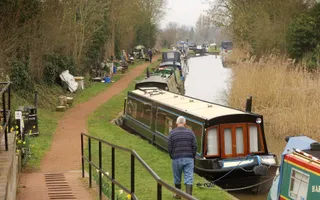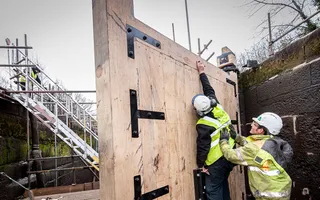The Droitwich Canals have been reborn from a derelict channel to become a thriving boating route and a peaceful retreat for the local community.
The Droitwich Barge Canal and Droitwich Junction Canal re-opened in 2011, after years of hard work by the Droitwich Canal Trust, local volunteers and ourselves in our former guise of British Waterways.
The canal flows through the spa town of Droitwich and is thickly lined with trees and hedges. At Vines Park, it forms the centre of a green haven for local people.
The re-opening of the Droitwich Canals has created a brand new cruising ring for boaters. The Mid-Worcestershire ring can easily be completed in a weekend's boating. It gives you the chance to explore the attractions of Droitwich, the cathedral city of Worcester, and the broad waters of the River Severn.
The restoration of the canals was carried out with careful consideration for nature. Coney Meadow reed bed was created to provide a home for wildlife displaced by the dredging of the canals. Otter holts, bat boxes and kestrel boxes have been added and trees and wild flowers planted. Ponds have been created as a habitat for the protected great crested newt.
The history
Natural brine springs have attracted people to Droitwich from very early times and created wealth for the town's inhabitants. First evidence of salt production dates to the late Iron Age and significant Roman remains have been found in the vicinity. The importance of Droitwich during the Anglo-Saxon period is evidenced by its tax yield, which, in 1066, was second only to London.
During the medieval period, salt production was monopolised within Droitwich and salt rights could only be passed on by inheritance. In 1695, this monopoly was successfully challenged and production dramatically expanded. Consequently the transportation needs of the town increased and in 1703 and 1747 bills were presented to make the River Salwarpe navigable, but these foundered. Pressure for good transportation increased when, in 1727, deep borings were made to expose stronger flows of brine - and salt output soared. It was not until 1767 that the Droitwich Council appointed famous canal engineer James Brindley to survey a route for a canal to link Droitwich with the River Severn that a solution was found, and in 1768, the Droitwich Barge Canal Act was passed and construction commenced.
James Brindley had built England's first large scale canal for the Duke of Bridgwater and was considered the country's leading expert on canal construction. The Barge Canal was typical of Brindley's work in following the contours of the land and was one of only a few canals to be completed in his lifetime. The Barge Canal opened in 1771 and was constructed as a wide canal in order to carry barges that came to be known as "Wich" boats, a smaller version of the Severn Trow.
Droitwich's dominance in the salt trade started to decline in 1828 when a new brine source was discovered at Stoke Prior to the north east of the town. The Birmingham & Gloucester railway opened in 1841, and the Oxford, Worcester & Wolverhampton Railway in 1851, both competing with the canal to service the salt trade.
The Droitwich Junction Canal was constructed in 1854 to link the Barge Canal in Droitwich to the Worcester & Birmingham Canal at Hanbury, in an attempt to revive trade on the Barge Canal, which was suffering from competition with the railways. A narrow waterway, it was one of the last canals to be built in England and included innovations such as water-conserving side ponds.
The last commercial barge used the Barge Canal in 1916 and by 1922, salt production in Droitwich had ceased. The canals were abandoned in 1939 and became redundant.











